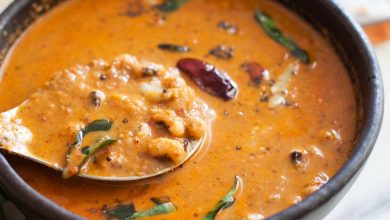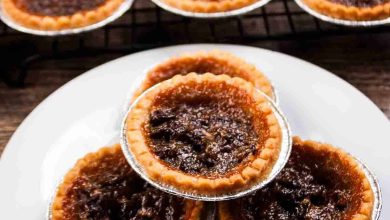Tawa Paratha Recipe – Plain Paratha
Tawa Paratha is a classic North Indian flatbread that is soft, flaky, and full of flavor. Perfect for a hearty meal or to accompany curries, dals, or vegetables, Tawa Paratha is an essential recipe in every kitchen. Whether you’re a seasoned cook or a beginner, this recipe will guide you to make delicious, restaurant-style parathas right on your stovetop with minimal ingredients.
Ingredients
| Ingredient | Quantity |
|---|---|
| Whole Wheat Flour | 1 cup |
| Salt | 1/2 teaspoon |
| Sunflower Oil (for kneading) | As required |
| Ghee (or oil for cooking) | As required |
Preparation Time: 20 minutes
Cooking Time: 20 minutes
Total Time: 40 minutes
Servings: 4
Cuisine: North Indian
Course: Main Course
Diet: Vegetarian
Instructions
-
Prepare the Dough:
In a large mixing bowl, combine the whole wheat flour and salt. Add 1 tablespoon of sunflower oil and begin kneading the dough by gradually adding small amounts of water. The goal is to form a firm yet smooth dough. Continue kneading for about 5 minutes until the dough is soft and pliable.Related Articles -
Rest the Dough:
Coat the dough with an additional tablespoon of oil to prevent it from drying out. Cover the bowl with a clean kitchen towel and allow the dough to rest for 15 minutes. This resting period helps the dough become more manageable and results in soft parathas. -
Divide the Dough:
Once the dough has rested, knead it again briefly. Divide the dough into 8 equal portions, shaping each portion into a smooth ball. Set the dough balls aside while you preheat your skillet. -
Roll the Dough:
Lightly flour your work surface and rolling pin. Take one dough ball, flatten it slightly with your palm, and toss it in the flour. Roll it out gently into a circle of approximately 3 inches in diameter. Be sure to keep the dough evenly floured to prevent sticking. -
Shape the Paratha:
Now, for the signature fold that creates the paratha’s layers: Drizzle 1/4 teaspoon of oil onto the rolled dough and spread it evenly. To shape the paratha into a triangle, fold the dough in half to form a semi-circle. Then, fold the semi-circle once more into a smaller half to create a triangle shape. -
Roll the Paratha into a Triangle:
Toss the folded dough triangle in a bit more flour and gently roll it out again into a larger triangle, approximately 5 to 6 inches in size. Repeat this process with the remaining dough balls. -
Cook the Paratha:
Heat an iron skillet (or tawa) over medium heat. Place the rolled-out paratha onto the hot skillet. You will notice air pockets starting to form on the surface. Let it cook for 1 to 2 minutes until the underside turns golden brown. -
Flip and Cook:
Flip the paratha over and immediately smear about 1/2 teaspoon of ghee or oil on the surface. Using a flat spatula, lightly press and turn the paratha to ensure even cooking and to help it puff up. -
Brown the Other Side:
After a minute, flip the paratha again to cook the other side. Continue pressing and turning the paratha, checking for golden brown spots and slight crispness. This process should take about 2 minutes per side, depending on your skillet’s heat. -
Serve:
Once the paratha is golden brown and crisp, remove it from the skillet and place it on a plate. Repeat the same process for the remaining dough portions, stacking the cooked parathas one on top of the other to keep them warm.
Serving Suggestions
Tawa Paratha is best served hot with your favorite curries, dals, or vegetable dishes. It pairs wonderfully with Batata Nu Shaak (spiced potato curry), Baingan Bharta (roasted eggplant curry), or Palak Dal (spinach lentils). You can also serve it with a dollop of yogurt or pickle on the side for an extra burst of flavor.
Tips for Perfect Tawa Paratha
- Kneading: Kneading the dough well is crucial for achieving soft parathas. Take your time and ensure the dough is smooth and elastic.
- Resting: Letting the dough rest is essential for achieving soft and tender parathas. If you don’t have time, you can skip this step, but it might affect the texture slightly.
- Rolling: When rolling out the paratha, try to keep it as even as possible. If it sticks to the rolling pin, dust it lightly with flour.
- Cooking on Medium Heat: The key to perfectly cooked parathas is medium heat. Too high a temperature will burn the paratha before it cooks through, and too low a heat will make it soggy.
- Layering the Parathas: The oil or ghee between the folds creates a flaky, layered texture in the paratha. Don’t skip this step!
Tawa Paratha is a versatile and easy-to-make dish that can be enjoyed as a part of any meal. Whether you’re having it with curries, raita, or even just a drizzle of ghee, it’s sure to be a favorite at your dinner table. Enjoy the warm, soft, and delicious parathas with your loved ones!




